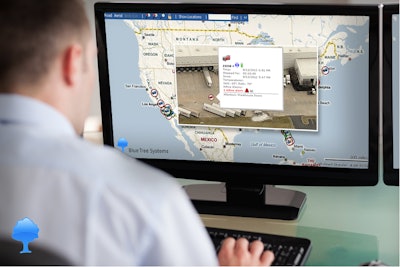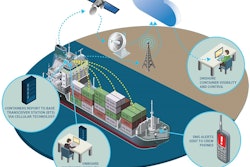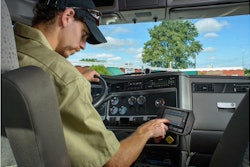
As technology advances and new regulations arise, fleet managers are seeking solutions that allow them to adapt with the times. Many are finding they need to examine different solutions as telematics technology evolves and offers new capabilities.
One of the newer fleet management tools is analytics, the application of advanced analysis of data to determine patterns and predict outcomes. Many of the newer electronic logging devices (ELDs) provide analytics capabilities that offer insight into driver safety and compliance.
According to Frost & Sullivan, the San Antonio, Texas-based consulting firm, every dollar spent on advanced analytics delivers an eight to 11 times return on investment and a restructuring of total cost of ownership (TCO) of trucks that yields a 2 to 3 percent reduction in TCO per vehicle per year.
Fleet managers will become more familiar with analytic tools as they begin to comply with the ELD mandate.
PFG Customized Distribution, a division of Performance Food Group Co. (PFG), is one of many food haulers that are investing in telematics technology to comply with laws and at the same time make fleet management easier.
The Richmond, Va.-based foodservice distributor recently deployed a customized mobile communication solution for its fleets that will allow it to improve its reefer command and control systems. The solution from Smyrna, Ga.-based CarrierWeb will enable allow the foodservice distributor to manage driver hours of service (HOS) at nine locations nationwide, facilitating compliance with the ELD mandate. The system will also allow remote monitoring of the company’s reefer fleet to comply with the Food Safety Modernization Act (FSMA) sanitary transport rule that is scheduled to take effect at the end of this month.
“We are impressed with the ability of CarrierWeb to address not only driver compliance, custom back office ERP integration, asset visibility for multi-stop deliveries, but also provide a refrigerated trailer management solution that addressed our need for two-way refrigeration monitoring and communication,” says Donnie Bain, senior vice president of business units at PFG Customized Distribution. “The refrigerated asset monitoring solution positions PFG for compliance with pending full implementation of the Food Safety Modernization Act regulations.”
Real-time reporting key
Dietz & Watson, a Philadelphia, Pa.-based manufacturer of delicatessen food, recently switched telematics providers because the system they were using had reliability issues and did not provide real-time reporting.
“Our goal was to install an electronic HOS system tied to real-time visibility of assets and dynamic routing,” says Greg Shields, Dietz & Watson’s transportation manager. “Our previous system was not capable of real-time reporting. We also wanted potential protection for the company in accident investigation.”
Dietz & Watson recently deployed ibrightDrive, an app-based system that combines multiple data sources within a single in-cab dashboard. The ibrightDrive from New Zealand-based International Telematics (Coretex) allows the driver to alert a customer if a delivery is running late. The most important features, according to Shields, are real-time tracking, geofencing, HOS logs, driver vehicle inspection reports (DVIRs), reefer visibility, monitoring unexpected or unauthorized stops, and engine monitoring.
Location, logs, and HOS reports are the company’s most-frequently utilized reports, Shields says. “We also use a variety of other reports for vehicle history, tracking, and driver behavior.” Real-time reporting is especially handy with backhaul pickups.
3PL: multiple concerns
NFI, the Cherry Hill, N.J.-based 3PL, appreciates the fact that its ELD solution provider, Dallas, Texas-based Omnitracs, makes it easy for drivers to comply with the new HOS rules, says Lee Robledo, vice president of safety and loss control. Omnitracs has features so that the fleet manager can be sure that the HOS time the driver logs accurately reflects the hours worked.
Another important consideration for NFI is the Omnitracs system’s ability to interface with external devices that enhance driver safety, Robledo says. In 2013, NFI added Lytx Drivecams from San Diego, Calif.-based Lytx to its trucks that capture and assist in correcting risky driving habits.
Along with electronic logging, Omnitracs captures critical event reporting (CER) which monitors NFI’s fleet for hard braking, lane departure, rear-end collision avoidance and roll stability. When a CER detects such an event, it sends a near real-time email alert to the safety team, as well as a message to the driver.
Last year, NFI started purchasing all new trucks with rear-end avoidance collision technology that automatically slows the vehicle to prevent a rear-end collision. “The systems are all talking to each other,” Robledo says. “All these systems are continuously improving our safety process.”
As fleets begin adding ELDs to comply with the mandate, managers and drivers alike will find ELDs help them comply with new reporting and temperature monitoring regulations.
An ELD will allow drivers to eliminate form and manner violations, which are usually caused by data entry errors, says Tom Cuthbertson, vice president of regulatory safety at Omnitracs.
Under the ELD mandate, drivers do not have to comply with the requirements if they travel within a 100 air-mile radius. Hence, the solution from Telogis in Aliso Viejo, Calif. automatically alerts drivers if they are traveling beyond the 100-air-mile radius. This is known as the short-haul exemption. “If you stay within the 100 air miles, you don’t have to take that 30-minute break,” says Kelly Frey, vice president of product marketing at Telogis.
Fleets will also need to ensure that the ELDs they use are listed on an ELD-approved website, which has not yet launched.
As mobile devices have become pervasive, fleet managers should recognize that the ELD mandate requires mobile devices to connect synchronously to the engine, says Frey. In addition, devices must have a mute function, drivers must certify any log changes made by management, and drivers must have access to their logs.
One of the biggest changes under the ELD mandate is the ELD data transfer for roadside inspections. Unlike the current automatic on-board recording device (AOBRD) rule, the ELD will now need to electronically send enforcement as a standard data file including all pertinent compliance information, says Elise Chianelli, director of safety and compliance at PeopleNet, based in Minnetonka, Minn. ELDs must be able to transfer data electronically via either a) a telematics method via wireless web service or email; or b) a local method capable of sending data via Bluetooth or USB 2.0. All electronic logging devices must conform to a standard display or printout format with a defined log header, graph grid and log event details, she says.
Food safety drives interest
Several telematics solutions providers reported getting more inquiries on account of the FSMA temperature monitoring requirement.
“Reports can be run to check temperatures in respect to location for certain times/days/trips,” says Ryan Driscoll, marketing manager at GPS Insight, a Scottsdale, Ariz.-based telematics solutions provider. “This is valuable when a customer calls to complain that their food delivery was spoiled. Management can check the temperature of the reefer during that delivery to verify whether or not it was the food delivery company’s fault or not.”
Blue Tree Systems’ refrigeration monitoring system supports both Thermo King and Carrier Transicold units to provide continuous reefer status updates every five minutes, says Tim Van Cleve, vice president of sales for the Greensboro, N.C.-based company. It also includes two-way reefer control, temperature monitoring, alerting of exceptions, fuel monitoring, service scheduling and a customizable reporting engine.
Cooltrax’s comprehensive temperature and asset monitoring and management solutions automate regulatory and commercial compliance requirements and provide real-time actionable business intelligence. A provider of real-time cold-chain monitoring and cloud-based management and analytics solutions, Alpharetta, Ga.-based Cooltrax enhances both Carrier and Thermo King systems with fully-automated, long-range wireless RFID temperature, product, and door sensors and an easy-to-use management dashboard providing the most comprehensive solution on the market, says Brad Bartlett, Cooltrax director of sales.
New tools arrive
Zonar offers its V3 control unit that transmits fault codes from the vehicle to maintenance and fleet managers, often before the driver is aware of a problem, says Fred Fakkema, vice president of compliance at the Seattle, Wash.-based company. Real-time fault code descriptions and vehicle performance data help fleet managers schedule shop time and maintenance resources to increase uptime and improve customer service. Customization options can ensure specific data and dashboards for each user, whether they are a fleet manager, mechanic, operations executive, equipment manager, or dispatcher.
One of the reasons PeopleNet acquired Cadec Global Inc. was the opportunity to pair its fleet mobility technology with Cadec’s back-end analytics tools specific to food distribution, says Angela Shue, general manager for PeopleNet’s PowerVue system. The ability to integrate direct-store-delivery (DSD) functions into PeopleNet’s fleet management system can deliver benefits in the areas of safety, advanced customer service and performance metrics. The solution now gathers food transport specific analytics. Drivers and fleet managers can monitor delivery progress in relation to customer commitments. It also integrates seamlessly with shippers’ ERP and WMS systems.
In the food industry, Shue says it is especially important to track how delivery activity compares to planned performance.
Colin Sutherland, executive vice president of sales at Ontario, Canada-based Geotab, thinks predictive maintenance is one of the most important improvements to come to market. A signal from the engine can alert the driver of maintenance concerns such as when a coolant is running low prior to the engine light going on. This will allow the driver to take care of the issue before an unplanned roadside failure. Now that all highway vehicles must deploy ELDs, incorporating this type of service will improve driver retention and maximize uptime, he says.
Sutherland also sees telematics making it easier to interface vehicle data with back office data. With access to driver logs, the payroll department could make sure the driver is paid accurately for the amount of time he or she actually spends driving. “This gives more opportunity to pay per hour versus mileage while maintaining IFTA requirements,” he says. “There is terrific opportunity for business to integrate.”
More to come
Further progress is on the horizon.
Vehicle OEMs are embedding onboard computers into their vehicles. As vehicles with built-in access to advanced analytics expand on the fleet landscape, fleets will have access to real-time management through subscription services.
Automatic hours of service alerts will reduce “out of service” inspection violations, says Cuthbertson at Omnitracs. The ELD requires integration with the ECM. “With additionally having exposure to vehicle faults there is active information from the vehicle that can initiate less costly repairs,” he says. “ in turn providing better customer service.”
The combination of satellite and cellular communication (dual mode) delivers telematics connectivity for near real-time alerts on fleet status, location, etc., providing greater visibility and utilization for businesses, says Tom Robinson, senior vice president for Fort Lee, N.J.-based ORBCOMM. ORBCOMM provides cold chain temperature and location monitoring for trailers, containers, chassis, rail cars, gensets and ocean vessels.
Ocean monitoring evolves
Remote temperature monitoring enables ocean transport.
Denmark-based A.P. Moller-Maersk Group recently connected more than 280,000 of its refrigerated containers to the AT&T network. Each unit uses a remote container device that has a 3G high-temperature SIM card, a GPS unit, a radio and antenna, and multiple interfaces for connecting to the refrigerated container’s controller.
Maersk supply chain managers will no longer have to manually check the condition of refrigerated container. Maersk has near-real time visibility into the conditions of each refrigerated container at almost any part of its journey. The shipping supervisors can monitor mechanical performance.
More information, more challenges
As solutions providers tout all these new capabilities, fleet managers can get overwhelmed by the amount of data involved. They can also have a hard time understanding how the technology works and/or how it will help them.
While fleets have invested in technology over the last several years to improve safety, optimize fleet operations and strengthen the bottom line, the real-time data stream generated by sensors and disparate on-board and back-office information systems has delivered a siloed “data dump.” This can make insights difficult, corrective action challenging and savings slow to realize.
Hence, to take advantage of the technologies that promise better management insights, fleet managers must work with technology suppliers to understand how the systems work and the level of aftermarket support offered.
“There is tremendous opportunity to address long-standing industry challenges, especially in areas of safety, with proactive intervention,” says Don Osterberg, a transportation advisor at SmartDrive Systems, a San Diego, Calif.-based provider of driving performance solutions. “To do that, solutions must create value from the explosion of fleet data and make those insights accessible to all fleets.”
For More Information:
A.P. Moller-Maersk Group, maersk.com
Blue Tree Systems, bluetreesystems.com
Carrier Transicold, carrier.com
CarrierWeb, carrierweb.com
Cooltrax, cooltrax.com
Frost & Sullivan, ww2.frost.com
Geotab, geotab.com
GPS Insight, gpsinsight.com
International Telematics (Coretex), internationaltelematics.com
Lytx, lytx.com
NFI, nfiindustries.com
Omnitracs, omnitracs.com
ORBCOMM, orbcomm.com
PeopleNet, peoplenetonline.com
SmartDrive Systems, smartdrive.net
Telogis, telogis.com
Thermo King, thermoking.com
Zonar, zonarsystems.com




















